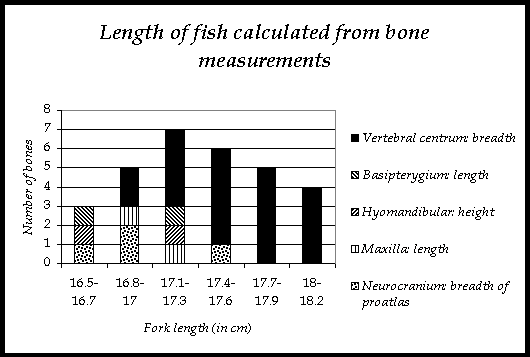 |
| Turiang |
25Feb2001
|
|||
| Last modified: 25Feb2001 |
The sample consists of 127 bone elements of which 119 have been classified. The bone substance is very well preserved. The identifications were made with the aid of recent specimens in the comparative collections of the author and Leif Jonsson, Gothenburg. It should be remarked that in our collections specimens of the Island mackerel are missing. The definition of measurements taken is that given by Morales & Rosenlund (1979). The conclusions that can be drawn are obviously limited because of the small sample size.
 The
fish remains identified from the 'Royal Nanhai' all came from a small
scombrid, a mackerel belonging to the genus Rastrelliger, Jordan & Starks
1908. The genus comprises three species, Short mackerel, R. brachysoma
(Bleeker, 1851), Island mackerel, R. faughni (Matsui, 1967) and
Indian mackerel, R. kanagurta (Cuvier, 1817).
The
fish remains identified from the 'Royal Nanhai' all came from a small
scombrid, a mackerel belonging to the genus Rastrelliger, Jordan & Starks
1908. The genus comprises three species, Short mackerel, R. brachysoma
(Bleeker, 1851), Island mackerel, R. faughni (Matsui, 1967) and
Indian mackerel, R. kanagurta (Cuvier, 1817).
Morphologically the fish bones from the 'Royal Nanhai' show the best agreement with comparative parts from recent Short mackerel, Rastrelliger brachysoma (Bleeker, 1851). According to Colette & Nauen (1983) the three species of Rastrelliger can all be caught in the South China Sea. They form schools of equally sized individuals and feed chiefly on plankton organisms. These species are nowadays caught the year round with native purse seines, encircling gillnets, liftnets, fish corrals and bamboo stake traps. Table 1 shows the intraskeletal distribution of the bones in the sample. There are at least 6 individuals represented in the material. The total absence of bone elements from the branchial apparatus could be an indication that the gill was removed and that the fish thereafter was prepared with salt and dried or smoked. Table 2 (omitted) shows the measurements taken. The estimated fork length of the mackerels from the 'Royal Nanhai' was 16-18 cm.

References:
| Turiang overview | Maritime Asia homepage | Back to non-ceramic finds |